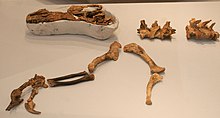Guanlong
| Guanlong | |
|---|---|

| |
| Mounted skeleton | |
| Scientific classification | |
| Domain: | Eukaryota |
| Kingdom: | Animalia |
| Phylum: | Chordata |
| Clade: | Dinosauria |
| Clade: | Saurischia |
| Clade: | Theropoda |
| Family: | †Proceratosauridae |
| Genus: | †Guanlong Xu et al., 2006 |
| Species: | †G. wucaii
|
| Binomial name | |
| †Guanlong wucaii Xu et al., 2006
| |
Guanlong (冠龍) is a
Discovery

Guanlong was discovered in the Dzungaria area of China by a joint expedition by scientists from the Institute of Vertebrate Paleontology and Paleoanthropology and George Washington University, and named by Xu Xing and others in 2006. Guanlong comes from the Chinese words for "crown", 冠, and "dragon", 龍, referring to the crest. The specific epithet (五彩), wucaii (Hanyu Pinyin: wǔcǎi), means "multicoloured" and refers to the colours of rock of the Wucaiwan (五彩灣, "5-colored bay", "multicolored bay"), the multi-hued badlands where the creature was found.[1][2]

At present, Guanlong is known from two specimens, one discovered on top of the other, with three other individual theropod dinosaurs, in the Shishugou Formation. The holotype (IVPP V14531) is a reasonably complete, partially articulated adult skeleton, and was the one on top. Another, immature specimen, the paratype IVPP V14532, is known from fully articulated and nearly complete remains. It was presumed to have been trampled, after death, by the adult. The crest on the skull of the immature specimen is notably smaller and restricted to the forward portion of the snout, while the adult has a larger and more extensive crest. The crests of both specimens are thin, delicate structures that likely served as display organs, possibly for events like mating.[1][2]
Description

Guanlong was a relatively small theropod, reaching 3–3.5 m (9.8–11.5 ft) in length and 125 kg (276 lb) in body mass.
Classification

In a recent study, Guanlong was found to be in a clade with both Proceratosaurus and Kileskus. Together they formed the family Proceratosauridae with a clade containing Sinotyrannus, Juratyrant and Stokesosaurus.[5] However, in 2014 another study was published, instead finding Stokesosaurus and Juratyrant outside the family, which only included Guanlong, Proceratosaurus, Kileskus and Sinotyrannus.[6]
Below is a simplified cladogram of the later analysis, from Fiorillo & Tykoski, 2014.[6]
Paleobiology

The age of the two individuals were determined using a
Guanlong possessed a cranial crest, which may have been used for display. It is similar to those of
See also
References
- ^ S2CID 4424849.
- ^ ISBN 978-1-7811-6912-4.
- ^ Holtz, Thomas R. Jr. (2008) Dinosaurs: The Most Complete, Up-to-Date Encyclopedia for Dinosaur Lovers of All Ages Supplementary Information
- OCLC 985402380.
- PMID 24223179.
- ^ PMID 24621577.
